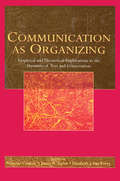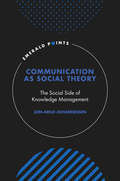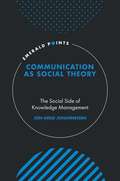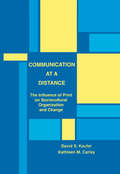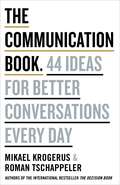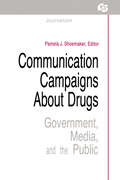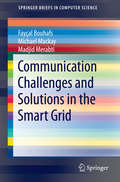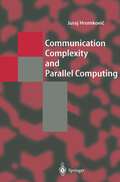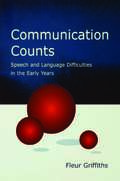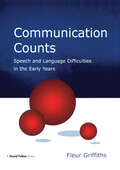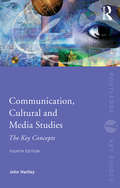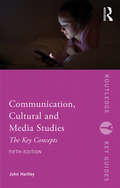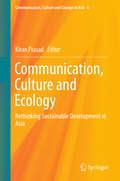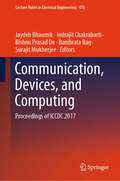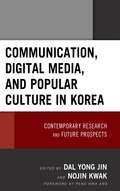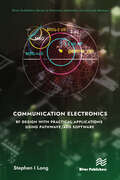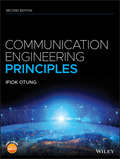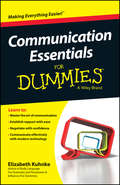- Table View
- List View
Communication as Organizing: Empirical and Theoretical Explorations in the Dynamic of Text and Conversation (Routledge Communication Series)
by Francois Cooren James R. Taylor Elizabeth J. Van EveryCommunication as Organizing unites multiple reflections on the role of language under a single rubric: the organizing role of communication. Stemming from Jim Taylor's earlier work, The Emergent Organization: Communication as Its Site and Surface (LEA, 2000), the volume editors present a communicational answer to the question, "what is an organization?" through contributions from an international set of scholars and researchers. The chapter authors synthesize various lines of research on constituting organizations through communication, describing their explorations of the relation between language, human practice, and the constitution of organizational forms. Each chapter develops a dimension of the central theme, showing how such concepts as agency, identity, sensemaking, narrative and account may be put to work in discursive analysis to develop effective research into organizing processes. The contributions employ concrete examples to show how the theoretical concepts can be employed to develop effective research. This distinctive volume encourages readers to discover and develop a truly communicational means of addressing the question of organization, addressing how organization itself emerges in the course of communicational transactions. In presenting a single and entirely communicational perspective for exploring organizational phenomena, grounded in the discourse of communicational transactions and the establishment of relationships through language, it is required reading for scholars, researchers, and graduate students working in organizational communication, management, social psychology, pragmatics of language, and organizational studies.
Communication as Social Theory: The Social Side of Knowledge Management (Emerald Points)
by Jon-Arild JohannessenCommunication as Social Theory: The Social Side of Knowledge Management develops a social theory at micro level, with communication as the essential social mechanism within the theory. Leadership expert Johannessen examines how we can advance communication as social theory. The communicative process has been framed as a sequence: select-create-detect. The 'select' element occurs when a positive choice to communicate something is made, thereby deselecting something else. In this book 44 case letters have been developed. These case letters are designed to deepen, underline and augment the 44 conceptual and empirical propositions that have been established. The core message is to promote change in social systems by focusing on changing micro-behaviours. In complex adaptable systems, the individual actors adapt their behaviour to each other on the basis of the local minimal rules. This means that one cannot take individual behaviour for granted, but one must instead investigate individual behaviour within specific contexts. For students of Management Studies and professionals in Leadership this work is a must for expanding their understanding.
Communication as Social Theory: The Social Side of Knowledge Management (Emerald Points)
by Jon-Arild JohannessenCommunication as Social Theory: The Social Side of Knowledge Management develops a social theory at micro level, with communication as the essential social mechanism within the theory. Leadership expert Johannessen examines how we can advance communication as social theory. The communicative process has been framed as a sequence: select-create-detect. The 'select' element occurs when a positive choice to communicate something is made, thereby deselecting something else. In this book 44 case letters have been developed. These case letters are designed to deepen, underline and augment the 44 conceptual and empirical propositions that have been established. The core message is to promote change in social systems by focusing on changing micro-behaviours. In complex adaptable systems, the individual actors adapt their behaviour to each other on the basis of the local minimal rules. This means that one cannot take individual behaviour for granted, but one must instead investigate individual behaviour within specific contexts. For students of Management Studies and professionals in Leadership this work is a must for expanding their understanding.
Communication at A Distance: The Influence of Print on Sociocultural Organization and Change (Routledge Communication Series)
by David S. Kaufer Kathleen M. CarleyThis book bridges an important gap between two major approaches to mass communication -- historical and social scientific. To do so, it employs a theory of communication that unifies social, cultural and technological concerns into a systematic and formal framework that is then used to examine the impact of print within the larger socio-cultural context and across multiple historical contexts. The authors integrate historical studies and more abstract formal representations, achieving a set of logically coherent and well-delimited hypotheses that invite further exploration, both historically and experimentally. A second gap that the book addresses is in the area of formal models of communication and diffusion. Such models typically assume a homogeneous population and a communication whose message is abstracted from the complexities of language processing. In contrast, the model presented in this book treats the population as heterogeneous and communications as potentially variable in their content as they move across speakers or readers. Written to address and overcome many of the disciplinary divisions that have prevented the study of print from being approached from the perspective of a unified theory, this book employs a focused interdisciplinary position that encompasses several domains. It shows the underlying compatibility between cognitive and social theory; between the study of language and cognition and the study of technology; between the postmodern interest in the instability of meaning and the social science interest in the diffusion of information; between the effects of technology and issues of cultural homogeneity and heterogeneity. Overall, this book reveals how small, relatively non-interactive, disciplinary-specific conversations about print are usefully conceived of as part of a larger interdisciplinary inquiry.
Communication at A Distance: The Influence of Print on Sociocultural Organization and Change (Routledge Communication Series)
by David S. Kaufer Kathleen M. CarleyThis book bridges an important gap between two major approaches to mass communication -- historical and social scientific. To do so, it employs a theory of communication that unifies social, cultural and technological concerns into a systematic and formal framework that is then used to examine the impact of print within the larger socio-cultural context and across multiple historical contexts. The authors integrate historical studies and more abstract formal representations, achieving a set of logically coherent and well-delimited hypotheses that invite further exploration, both historically and experimentally. A second gap that the book addresses is in the area of formal models of communication and diffusion. Such models typically assume a homogeneous population and a communication whose message is abstracted from the complexities of language processing. In contrast, the model presented in this book treats the population as heterogeneous and communications as potentially variable in their content as they move across speakers or readers. Written to address and overcome many of the disciplinary divisions that have prevented the study of print from being approached from the perspective of a unified theory, this book employs a focused interdisciplinary position that encompasses several domains. It shows the underlying compatibility between cognitive and social theory; between the study of language and cognition and the study of technology; between the postmodern interest in the instability of meaning and the social science interest in the diffusion of information; between the effects of technology and issues of cultural homogeneity and heterogeneity. Overall, this book reveals how small, relatively non-interactive, disciplinary-specific conversations about print are usefully conceived of as part of a larger interdisciplinary inquiry.
The Communication Book: 44 Ideas for Better Conversations Every Day
by Roman Tschäppeler Mikael KrogerusThe authors of the international bestseller The Decision Book teach us how to communicate better at work and in everyday lifeThe internationally bestselling duo Mikael Krogerus and Roman Tschäppeler have tested the 44 most important communication theories - from Aristotle's thoughts on presenting through Proust on asking questions to the Harvard Negotiation Project - for their practicality in daily business life. In The Communication Book they distil them into a single volume that in their winning way turns seemingly difficult ideas into clear and entertaining diagrams.From running better meetings and improving the conversations in your head to brushing up on your listening skills and small talk, the pair masterfully fuses theoretical knowledge and business advice with humour and practicality. They show that we can improve not only what we communicate, but how we do so. Whether you're a CEO or starting out - or want to improve your relationships at home - this smartly-illustrated and compact guide will improve your communication skills and help you form more meaningful connections at work, while smiling too.
Communication Campaigns About Drugs: Government, Media, and the Public (Routledge Communication Series)
by Pamela J. ShoemakerPublished in 1989, Communication Campaigns About Drugs is a valuable contribution to the field of Communication Studies.
Communication Campaigns About Drugs: Government, Media, and the Public (Routledge Communication Series)
by Pamela J. ShoemakerPublished in 1989, Communication Campaigns About Drugs is a valuable contribution to the field of Communication Studies.
Communication Challenges and Solutions in the Smart Grid (SpringerBriefs in Computer Science)
by Fayҫal Bouhafs Michael Mackay Madjid MerabtiThis SpringerBrief discusses the rise of the smart grid from the perspective of computing and communications. It explains how current and next-generation network technology and methodologies help recognize the potential that the smart grid initiative promises. Chapters provide context on the smart grid before exploring specific challenges related to communication control and energy management. Topics include control in heterogeneous power supply, solutions for backhaul and wide area networks, home energy management systems, and technologies for smart energy management systems. Designed for researchers and professionals working on the smart grid, Communication Challenges and Solutions in the Smart Grid offers context and applications for the common issues of this developing technology. Advanced-level students interested in networking and communications engineering will also find the brief valuable.
Communication Complexity and Parallel Computing (Texts in Theoretical Computer Science. An EATCS Series)
by Juraj HromkovičThe communication complexity of two-party protocols is an only 15 years old complexity measure, but it is already considered to be one of the fundamen tal complexity measures of recent complexity theory. Similarly to Kolmogorov complexity in the theory of sequential computations, communication complex ity is used as a method for the study of the complexity of concrete computing problems in parallel information processing. Especially, it is applied to prove lower bounds that say what computer resources (time, hardware, memory size) are necessary to compute the given task. Besides the estimation of the compu tational difficulty of computing problems the proved lower bounds are useful for proving the optimality of algorithms that are already designed. In some cases the knowledge about the communication complexity of a given problem may be even helpful in searching for efficient algorithms to this problem. The study of communication complexity becomes a well-defined indepen dent area of complexity theory. In addition to a strong relation to several funda mental complexity measures (and so to several fundamental problems of com plexity theory) communication complexity has contributed to the study and to the understanding of the nature of determinism, nondeterminism, and random ness in algorithmics. There already exists a non-trivial mathematical machinery to handle the communication complexity of concrete computing problems, which gives a hope that the approach based on communication complexity will be in strumental in the study of several central open problems of recent complexity theory.
Communication Counts: Speech and Language Difficulties in the Early Years
by Fleur GriffithsProfessionals in early years settings can use this book to focus on ways in which they can work collaboratively with colleagues, in order to help children with communication difficulties to understand and express themselves more fully. It brings together the most useful examples of good practice and draws on the work of reflective practitioners. There are many illustrative case studies provided and it discusses how to observe children's daily interactions, ways in which such observations can be used to improve communication skills; how play can be an important part of improvement; behavior management and support; and literacy development. The practical applications are highlighted throughout the book and the advice given comes directly from those working in early years settings. It should be of great interest to all nursery teachers, teaching assistants, speech and language therapists and parents wishing to play an active part in their children's development of language and communication skills.
Communication Counts: Speech and Language Difficulties in the Early Years
by Fleur GriffithsProfessionals in early years settings can use this book to focus on ways in which they can work collaboratively with colleagues, in order to help children with communication difficulties to understand and express themselves more fully. It brings together the most useful examples of good practice and draws on the work of reflective practitioners. There are many illustrative case studies provided and it discusses how to observe children's daily interactions, ways in which such observations can be used to improve communication skills; how play can be an important part of improvement; behavior management and support; and literacy development. The practical applications are highlighted throughout the book and the advice given comes directly from those working in early years settings. It should be of great interest to all nursery teachers, teaching assistants, speech and language therapists and parents wishing to play an active part in their children's development of language and communication skills.
Communication, Cultural and Media Studies: The Key Concepts (Routledge Key Guides)
by John HartleyThis fourth edition of Communication, Cultural and Media Studies: The Key Concepts is an indispensible guide to the most important terms in the field. It offers clear explanations of the key concepts, exploring their origins, what they’re used for and why they provoke discussion. The author provides a multi-disciplinary explanation and assessment of the key concepts, from ‘authorship’ to ‘censorship’; ‘creative industries’ to ‘network theory’; ‘complexity’ to ‘visual culture’. The new edition of this classic text includes: Over 200 entries including 50 new entries All entries revised, rewritten and updated Coverage of recent developments in the field Insight into interactive media and the knowledge-based economy A fully updated bibliography with 400 items and suggestions for further reading throughout the text
Communication, Cultural and Media Studies: The Key Concepts (Routledge Key Guides)
by John HartleyThis fourth edition of Communication, Cultural and Media Studies: The Key Concepts is an indispensible guide to the most important terms in the field. It offers clear explanations of the key concepts, exploring their origins, what they’re used for and why they provoke discussion. The author provides a multi-disciplinary explanation and assessment of the key concepts, from ‘authorship’ to ‘censorship’; ‘creative industries’ to ‘network theory’; ‘complexity’ to ‘visual culture’. The new edition of this classic text includes: Over 200 entries including 50 new entries All entries revised, rewritten and updated Coverage of recent developments in the field Insight into interactive media and the knowledge-based economy A fully updated bibliography with 400 items and suggestions for further reading throughout the text
Communication, Cultural and Media Studies: The Key Concepts (Routledge Key Guides)
by John HartleyNow in its fifth edition, this pioneering volume of Routledge’s ‘Key Concepts’ series offers clear explanations of key concepts, showing where they came from, what they are used for, and why they provoke discussion or disagreement. The new edition is extensively revised to keep pace with rapidly evolving developments in communication, culture and media, providing topical and authoritative guidance to transformational shifts from broadcast to digital technologies, national to global media and disciplinary to diverse knowledge. It includes: Nearly 250 entries, covering what and how to study across this multi-disciplinary field 50 new entries: from algorithm and assemblage, dance and data, to woke and worldbuilding Updated references with 500 items and suggestions for further reading Revisions, updates and examples throughout. For students and seasoned scholars alike, Communication, Cultural and Media Studies is an invaluable resource in an ever-changing landscape.
Communication, Cultural and Media Studies: The Key Concepts (Routledge Key Guides)
by John HartleyNow in its fifth edition, this pioneering volume of Routledge’s ‘Key Concepts’ series offers clear explanations of key concepts, showing where they came from, what they are used for, and why they provoke discussion or disagreement. The new edition is extensively revised to keep pace with rapidly evolving developments in communication, culture and media, providing topical and authoritative guidance to transformational shifts from broadcast to digital technologies, national to global media and disciplinary to diverse knowledge. It includes: Nearly 250 entries, covering what and how to study across this multi-disciplinary field 50 new entries: from algorithm and assemblage, dance and data, to woke and worldbuilding Updated references with 500 items and suggestions for further reading Revisions, updates and examples throughout. For students and seasoned scholars alike, Communication, Cultural and Media Studies is an invaluable resource in an ever-changing landscape.
Communication, Culture and Ecology: Rethinking Sustainable Development in Asia (Communication, Culture and Change in Asia #6)
by Kiran PrasadThis book offers comprehensive insights into the cultural and ecological values that influence sustainable development across Asia, addressing the cultural, religious and philosophical moorings of development through participatory and grassroots communication approaches. It presents a range of contributions and case studies from leading experts in Asia to highlight the debates on environmental communication and sustainable development that are relevant today, and to provide an overview of the positive traditions of ecological sensitivity and cultural communication that may find common ground between communities. This well-researched guide to the dynamic and complex terrain of communication for sustainable development offers uniquely practical perspectives on communication, environment and sustainable development that are of immense value for policy makers, media scholars, development practitioners, researchers and students of communication and media studies.
Communication, Devices, and Computing: Proceedings of ICCDC 2017 (Lecture Notes in Electrical Engineering #470)
by Jaydeb Bhaumik Indrajit Chakrabarti Bishnu Prasad De Banibrata Bag Surajit MukherjeeThis book provides insights into the First International Conference on Communication, Devices and Computing (ICCDC 2017), which was held in Haldia, India on November 2–3, 2017. It covers new ideas, applications and the experiences of research engineers, scientists, industrialists, scholars and students from around the globe. The proceedings highlight cutting-edge research on communication, electronic devices and computing, and address diverse areas such as 5G communication, spread spectrum systems, wireless sensor networks, signal processing for secure communication, error control coding, printed antennas, analysis of wireless networks, antenna array systems, analog and digital signal processing for communication systems, frequency selective surfaces, radar communication, and substrate integrated waveguide and microwave passive components, which are key to state-of-the-art innovations in communication technologies.
Communication, Digital Media, And Popular Culture In Korea: Contemporary Research And Future Prospects (PDF)
by Kim Jin Youm PaeIn recent decades, Korean communication and media have substantially grown to become some of the most significant segments of Korean society. Since the early 1990s, Korea has experienced several distinctive changes in its politics, economy, and technology, which are directly related to the development of local media and culture. Korea has greatly developed several cutting-edge technologies, such as smartphones, video games, and mobile instant messengers to become the most networked society throughout the world. As the Korean Wave exemplifies, the once small and peripheral Korea has also created several unique local popular cultures, including television programs, movies, and popular music, known as K-pop, and these products have penetrated many parts of the world. As Korean media and popular culture have rapidly grown, the number of media scholars and topics covering these areas in academic discourses has increased. These scholars' interests have expanded from traditional media, such as Korean journalism and cinema, to several new cutting-edge areas, like digital technologies, health communication, and LGBT-related issues. In celebrating the Korean American Communication Association's fortieth anniversary in 2018, this book documents and historicizes the growth of growing scholarship in the realm of Korean media and communication.
Communication Electronics: RF Design with Practical Applications using Pathwave/ADS Software (River Publishers Series in Electronic Materials, Circuits and Devices)
by Stephen I LongThis text/reference develops practical intuition into the art of RF circuit design and introduces users to the widely used simulation tool, Pathwave ADS, from Keysight Technologies. By using project-oriented assignments, it builds a strong foundation and focuses on practical applications illustrated by examples, simulation tutorials, and homework problems. Learning through doing has proven to be an effective preparatory tool for more advanced and complex applications, and this book is developed from the author’s lecture notes for a senior/graduate class at University of California Santa Barbara. The class had a significant lab component employing measurement techniques, board-level prototyping, and RFIC design. Falling somewhere between a traditional textbook and a practical handbook, it focuses mainly on analog RF analysis and design and circuit simulation techniques.
Communication Electronics: RF Design with Practical Applications using Pathwave/ADS Software (River Publishers Series in Electronic Materials, Circuits and Devices)
by Stephen I LongThis text/reference develops practical intuition into the art of RF circuit design and introduces users to the widely used simulation tool, Pathwave ADS, from Keysight Technologies. By using project-oriented assignments, it builds a strong foundation and focuses on practical applications illustrated by examples, simulation tutorials, and homework problems. Learning through doing has proven to be an effective preparatory tool for more advanced and complex applications, and this book is developed from the author’s lecture notes for a senior/graduate class at University of California Santa Barbara. The class had a significant lab component employing measurement techniques, board-level prototyping, and RFIC design. Falling somewhere between a traditional textbook and a practical handbook, it focuses mainly on analog RF analysis and design and circuit simulation techniques.
Communication Engineering Principles
by Ifiok OtungFor those seeking a thorough grounding in modern communication engineering principles delivered with unrivaled clarity using an engineering-first approach Communication Engineering Principles: 2nd Edition provides readers with comprehensive background information and instruction in the rapidly expanding and growing field of communication engineering. This book is well-suited as a textbook in any of the following courses of study: Telecommunication Mobile Communication Satellite Communication Optical Communication Electronics Computer Systems Primarily designed as a textbook for undergraduate programs, Communication Engineering Principles: 2nd Edition can also be highly valuable in a variety of MSc programs. Communication Engineering Principles grounds its readers in the core concepts and theory required for an in-depth understanding of the subject. It also covers many of the modern, practical techniques used in the field. Along with an overview of communication systems, the book covers topics like time and frequency domains analysis of signals and systems, transmission media, noise in communication systems, analogue and digital modulation, pulse shaping and detection, and many others.
Communication Engineering Principles
by Ifiok OtungFor those seeking a thorough grounding in modern communication engineering principles delivered with unrivaled clarity using an engineering-first approach Communication Engineering Principles: 2nd Edition provides readers with comprehensive background information and instruction in the rapidly expanding and growing field of communication engineering. This book is well-suited as a textbook in any of the following courses of study: Telecommunication Mobile Communication Satellite Communication Optical Communication Electronics Computer Systems Primarily designed as a textbook for undergraduate programs, Communication Engineering Principles: 2nd Edition can also be highly valuable in a variety of MSc programs. Communication Engineering Principles grounds its readers in the core concepts and theory required for an in-depth understanding of the subject. It also covers many of the modern, practical techniques used in the field. Along with an overview of communication systems, the book covers topics like time and frequency domains analysis of signals and systems, transmission media, noise in communication systems, analogue and digital modulation, pulse shaping and detection, and many others.
Communication Essentials For Dummies (For Dummies)
by Elizabeth KuhnkeGet ahead in your personal and professional life with crowd-pleasing communication skills Packed with advice on improving verbal and non-verbal communication skills alike, Communication Essentials For Dummies is a comprehensive, approachable guide to communication no one should be without. Utilising a core range of simple skills, this friendly guide shows you how easy it is to communicate effectively. You'll find out how to listen actively, establish rapport, communicate with credibility, manage communication in difficult situations and converse with ease using modern technology — and lots more. Great communication skills can make all the difference in your personal and professional life, but for those who tend to get a bit tongue-tied under pressure or just have a hard time asserting themselves, voicing thoughts coherently and confidently can be a sweat-inducing experience. Here, expert author Elizabeth Kuhnke takes the intimidation out of communication by sharing her top tips for successful communication in any situation. Discover how to get ahead in the workplace by mastering your communication skills Realise the benefits of active listening and the value of establishing rapport Understand how the use of effective communication skills can help you secure a new job offer Recognise how to use effective communication to negotiate your way to personal and professional success Whether you're looking to climb the corporate ladder, take on a new professional challenge or just want to improve your communication skills in personal and professional relationships, Communication Essentials For Dummies will have you listening, voicing and articulating your way to success in no time.
Communication Essentials For Dummies
by Elizabeth KuhnkeGet ahead in your personal and professional life with crowd-pleasing communication skills Packed with advice on improving verbal and non-verbal communication skills alike, Communication Essentials For Dummies is a comprehensive, approachable guide to communication no one should be without. Utilising a core range of simple skills, this friendly guide shows you how easy it is to communicate effectively. You'll find out how to listen actively, establish rapport, communicate with credibility, manage communication in difficult situations and converse with ease using modern technology — and lots more. Great communication skills can make all the difference in your personal and professional life, but for those who tend to get a bit tongue-tied under pressure or just have a hard time asserting themselves, voicing thoughts coherently and confidently can be a sweat-inducing experience. Here, expert author Elizabeth Kuhnke takes the intimidation out of communication by sharing her top tips for successful communication in any situation. Discover how to get ahead in the workplace by mastering your communication skills Realise the benefits of active listening and the value of establishing rapport Understand how the use of effective communication skills can help you secure a new job offer Recognise how to use effective communication to negotiate your way to personal and professional success Whether you're looking to climb the corporate ladder, take on a new professional challenge or just want to improve your communication skills in personal and professional relationships, Communication Essentials For Dummies will have you listening, voicing and articulating your way to success in no time.
